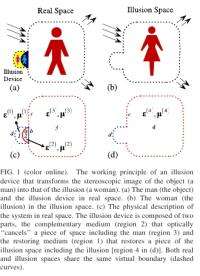July 9, 2009 feature
Transform a ball into a rock -- or make it invisible -- using transformation optics

(�鶹��ԺOrg.com) -- Science fiction and fantasy tales are full of the ability to "cloak" characters with invisibility. Whether it is a spaceship with a cloaking device, or a young wizard with an invisibility cloak, the interest in rendering someone or something invisible captures our fancy. Scientists have succeeded in creating the illusion of invisibility by bending light around a region for concealment. These types of devices have limitations, however; one of these limitation that the device normally has to be touching the object to be rendered invisible - or in very close proximity.
Instead of bending light, though, what if transformation optics was used to create invisibility - or even give an object the appearance of a completely different object? A team of theorists at the Hong Kong University of Science and Technology propose a technique that might be able to accomplish just that, with a remote device. The group’s proposal appears in �鶹��Ժical Review Letters: “Illusion Optics: The Optical Transformation of an Object into Another Object.”
“Right now, invisibility devices bend light, steering it around an object to make it appear transparent, as if it weren’t there,” Che Ting Chan tells �鶹��ԺOrg.com. Chan is one of the scientists who proposed the idea of a device that would use illusion optics to transform objects within a confined space. “Our proposed device would have special properties. It would employ a type of illusion that makes an object look exactly like another object.”
Metamaterials, which are manmade with special properties, would be used. A “complementary medium” would be employed to optically cancel a specified area. Then, a “restoring medium” would be used to make the cancelled space “reappear” as something else. For invisibility, the restored area would look like air. “If it looks like air,” Chan explains, “then it is transparent. You can see through it. It is like making something invisible.” This method could also, theoretically, be used to “transform” objects. “You could make a ball look like a rock,” Chan says. “You could hide something in plain sight, as something else.”
In addition to transforming the way an object looks to others, this device would have another advantage over current invisibility devices. “You wouldn’t have to need the device to touch the object being hidden,” Chan insists. “You could remotely control a particular area to entirely exclude a specific wave without having to be as close.”
While the device sounds promising, Chan admits that there are difficulties involved in building such a cloak. “In addition to positive refractive material, which is not a big problem, we would require a negative refractive index.” Positive refractive materials are easily made, but something with a negative refractive index would require special design. “Some sort of structure to create a phase delay would be needed,” Chan says.
Chan and the Hong Kong team are working on interesting experimentalists in the concept. “We are dealing with electromagnetic waves,” Chan explains, “but there are those who are doing similar experiments with acoustic waves. Maybe if our idea was applied to acoustic waves first, it would be easier to see how to extend it to include light.”
More Information: Yun Lai, Jack Ng, HuanYang Chen, DeZhuan Han, JunJun Xiao, Zhao-Qing Zhang, and C.T. Chan, “Illusion Optics: The Optical Transformation of an Object into Another Object,” �鶹��Ժical Review Letters (2009). Available online: .
Copyright 2009 �鶹��ԺOrg.com.
All rights reserved. This material may not be published, broadcast, rewritten or redistributed in whole or part without the express written permission of �鶹��ԺOrg.com.















